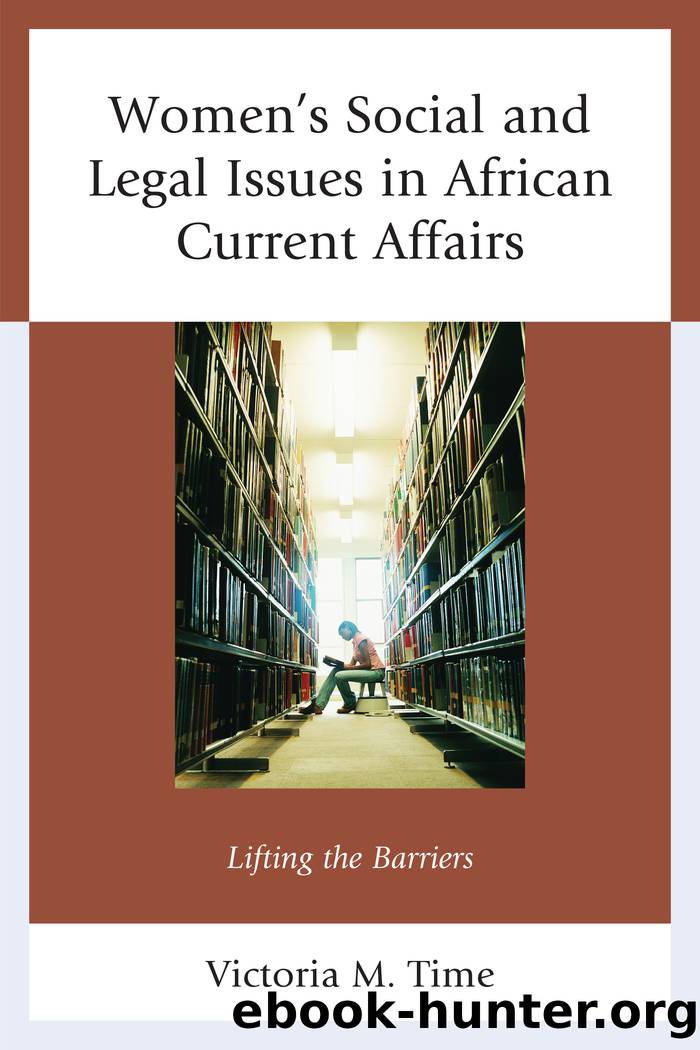Women's Social and Legal Issues in African Current Affairs by Time Victoria M.;Austin Timothy;

Author:Time, Victoria M.;Austin, Timothy;
Language: eng
Format: epub
Tags: undefined
Publisher: Lexington Books/Fortress Academic
Published: 2012-08-15T00:00:00+00:00
Crimes of Culture
Forced Marriages, Bride Price, Levirate, Female Circumcision, and Violence Against Women
Forced Marriages
Much has been written about female victimizations in Africa, particularly those that are rooted in custom, such as forced marriages, bride price, levirate responsibilities, and female circumcision (Bentheim 2010; Bunch 1990; Chigbu et al. 2010; Kaye et al. 2005; Kiragu 1996; Park 2006; Welch and Sachs 1987; Welstead 2009). It is worth noting that many of these practices are coming under severe scrutiny and criticism even in the countries where the practices still go on. Many proponents of the practices, who see them as embedded in custom and tradition, are gradually re-thinking their stances in light of education. Womenâs rights movements, non-governmental organizations, community groups, and other organizations are spreading awareness about the backwardness of the practices. Some countries such as Benin ban these practices outright, while some countries have legislations that punish the practices, even if the laws are not enforced.
According to ForwardUK, forced marriage is a union âconducted without the valid consent of one of both parties and is a marriage in which duressâwhether physical or emotional is a factorâ (Welstead 2009). Both adults and children as young as seven years old can be, and have been victims of this repressive practice (UNFPA 2005, Child Marriage Factsheet). A corollary of forced marriage, and occasionally independent of it is bride price. âBride price is a sum, either in cash or kind, used to purchase a bride for her labour and fertilityâ (ForwardUK). Bishai and Grossbard (2010) explain that bride price âinvolves the payment of goods or cash from the groomâs family to the brideâs family at the time of the marriageâ (1177). Data provided by Monekosso (2001) approximates that in Mali 72 percent, Niger 57 percent, Uganda 47 percent, Burkina Faso 44 percent, Cameroon 41 percent, Nigeria 37 percent, Central African Republic 39 percent, Malawi 36 percent, Liberia 32 percent, Senegal 29 percent, Togo 27 percent, Zambia 27 percent, Ivory Coast 26 percent, and Tanzania 26 percent of girls between the ages of 15â19 are forced into marriage.
IRIN Africa (2007), places the percentage of women married in Mali between the ages of 20â24 at 69 percent, and states that these women were married before they reached the age of 18. The same source reveals that one out of every ten girls who got married between the ages of 15â19 went on to have babies before they even got to be 15 (IRIN Africa, 2007). Even though accounts place the incidences of forced marriages very high in Mali, as a matter of fact, highest among African countries with data on the problem, on February 22, 2007, the president of the Malian Human Rights Association (Association Malienne des droits de Lâhomme, AMDH) disputed the claim, but conceded that the practice occurs in the country, but in far lower numbers (Refworld, 2012). However, on February 23, 2007, office of the Research Directorate received a letter from the president of the Association for the Progress and Defense of the Rights
Download
This site does not store any files on its server. We only index and link to content provided by other sites. Please contact the content providers to delete copyright contents if any and email us, we'll remove relevant links or contents immediately.
| Anthropology | Archaeology |
| Philosophy | Politics & Government |
| Social Sciences | Sociology |
| Women's Studies |
Cecilia; Or, Memoirs of an Heiress — Volume 1 by Fanny Burney(32075)
Cecilia; Or, Memoirs of an Heiress — Volume 3 by Fanny Burney(31469)
Cecilia; Or, Memoirs of an Heiress — Volume 2 by Fanny Burney(31419)
The Great Music City by Andrea Baker(30797)
We're Going to Need More Wine by Gabrielle Union(18641)
All the Missing Girls by Megan Miranda(14788)
Pimp by Iceberg Slim(13798)
Bombshells: Glamour Girls of a Lifetime by Sullivan Steve(13698)
Fifty Shades Freed by E L James(12925)
Talking to Strangers by Malcolm Gladwell(12888)
Norse Mythology by Gaiman Neil(12861)
For the Love of Europe by Rick Steves(11558)
Crazy Rich Asians by Kevin Kwan(8898)
Mindhunter: Inside the FBI's Elite Serial Crime Unit by John E. Douglas & Mark Olshaker(8721)
The Lost Art of Listening by Michael P. Nichols(7170)
Enlightenment Now: The Case for Reason, Science, Humanism, and Progress by Steven Pinker(6879)
The Four Agreements by Don Miguel Ruiz(6326)
Bad Blood by John Carreyrou(6284)
Weapons of Math Destruction by Cathy O'Neil(5846)
